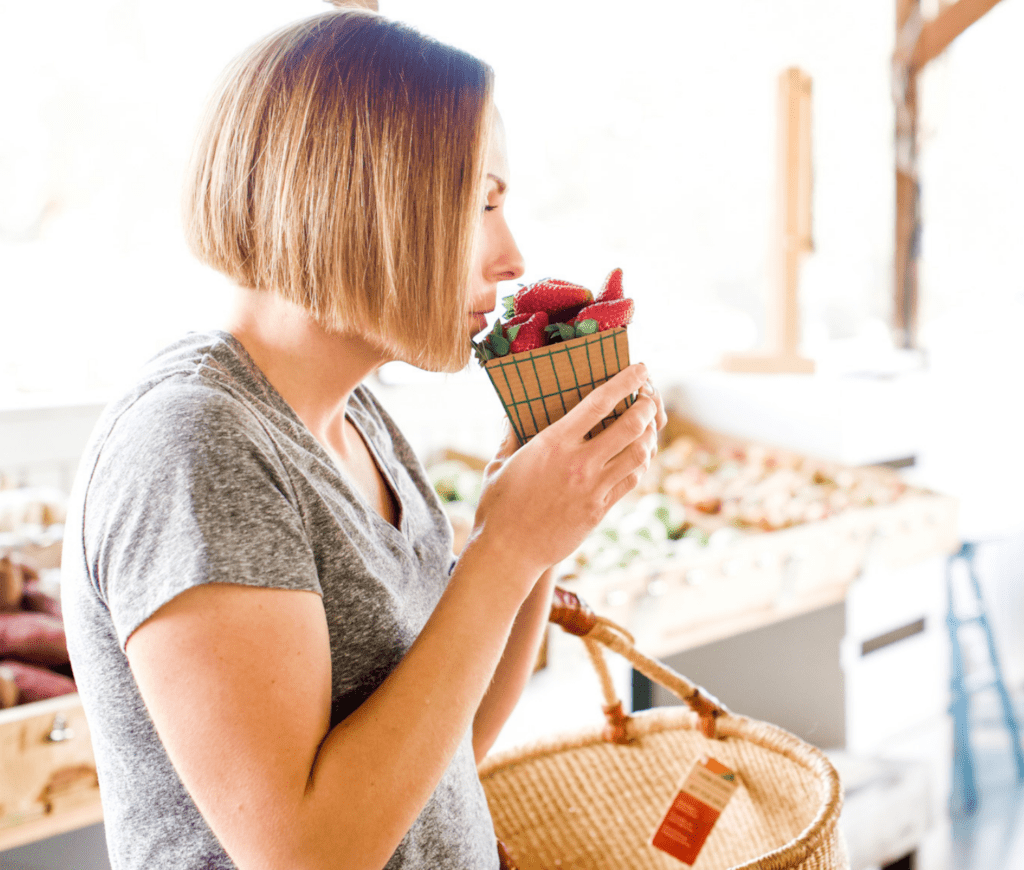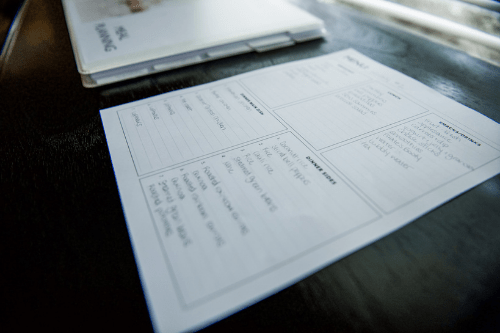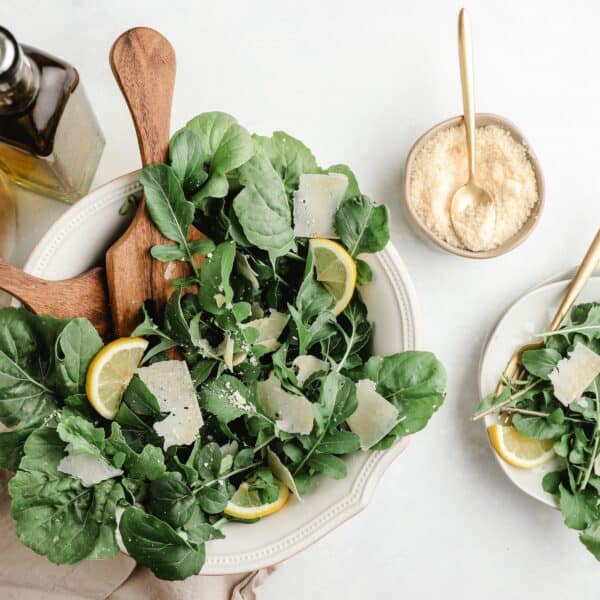Bring your family back to the dinner table with these five simple meal planning tips.
I have a confession to make: I really don’t like to cook. So why the heck am I writing about meal planning tips?
Here’s why: It makes me the perfect person to give you these meal planning ideas because I used to struggle with it, too.
- I’d buy a bunch of food and throw a lot of it away at the end of the week. I felt guilty being so wasteful.
- We’d run out to grab dinner at the last minute and I was ashamed because I wasn’t feeding my family healthy food.
- I’d regret wasting money each month for the pre-made weekly meal plans and shopping lists that didn’t fit my family’s lifestyle.
I felt like a total failure.
I knew there had to be an easier way, but none of the blogs I read helped me. I knew I’d have to figure it out on my own. It took me a while, but now I feel like I finally have control over our meals.
Once I figured it out, I started sharing my method with friends and family, and many of them told me they’d never thought to do it the way I do. So that’s what I’m sharing with you right now!

**This post contains affiliate links. If you click and make a purchase, I may receive a small commission (at no additional cost to you). Read my affiliate disclosure for more info.**
Simple Meal Planning Tips
1. Save your weekly meal plan and re-use it.
The secret to remember is this: once you’ve created a meal plan for the week – what I call a menu – use it again! Why do we spend all this time making menus and shopping lists each week, only to throw them away when we’re finished? Then we start all over again the next week, doing the same thing.
If you make enough menus, you’ll have a large selection that you can rotate and not get bored.
Even if you don’t want to use the same exact menu, you can easily swap out a main dish or a side and still have more of a starting point than if you just started from scratch.
I like to refer to this as minimalist meal planning. (Or lazy meal planning. That’s probably a more accurate description.)

2. Shop at the same stores and organize your list by how you walk through each store.
Number two is a two-part secret, and it’s made my shopping so much faster. (Also, leaving the kids at home also makes shopping faster, too.)
Shop at the same stores.
Stores have different layouts, even ones in the same chain. I’m lucky where I live to have three Trader Joe’s within a few miles of our house, plus a bunch of regular grocery store chains. But I shop at the same Trader Joe’s, the same Costco, and the same Sprouts.
I remember one time walking into the Trader Joe’s near my gym and stopping dead in my tracks. I rarely go to that one because parking is a nightmare. When I walked in, I remembered that the layout is different from the normal one I go to. It took me so much longer to get just a few items because I zig-zagged all over the store. It was crowded, I smelled funky from the gym, and I just wanted to get out of there.

Organize your list by how you walk through the store.
Once you’ve decided on your stores, organize your shopping list by how you walk through each store.
I know what you’re thinking right now, “But Karen, stores change their layouts ALL the time.” No, actually they don’t. I’ve been organizing my shopping lists this way consistently for several years, and stores move things less often than you think. It seems like Costco does all the time, but it’s usually just a few items that they switch around. And even if it is a massive reorganization, the store’s not going to do it very often so just update your list.
A lot of people suggest grouping similar items together, like dairy, but that usually isn’t efficient. For example, milk and cheese are in opposite corners of the store at my Sprouts. Have you ever tried to backtrack through a grocery store on a Sunday with little kinds in tow? It’s awful.
Create store “maps.”
Now before you try to organize, it’s helpful to create what I call store maps. Make a special trip to your stores and write down the flow of each one. Write what’s generally in each aisle so that you know how to sort your weekly shopping lists. Then create a digital document in whatever word processor or spreadsheet you use, like Google Docs or Microsoft Word or Excel, that you save and print for your binder (if you use one) to help you organize your shopping lists.
While this might seem like a lot of work, I promise it’s still better than wandering all over the store each time you go. Put in the work up front and it’ll save you a lot of time in the long run.

3. Cook from recipes.
Okay, this one you’ve heard of before! But you may not have heard my reasons why you should cook from recipes.
Less food waste.
If you buy based on the recipes you’ve selected, you’re less likely to throw away food at the end of the week because you actually know what you’re going to make.
According to the Natural Resources Defense Council, the average American throws away more than 400 pounds of food per person per year. That means a family of four wastes approximately $1,800 per year!
I felt sick when I read those stats because we used to be part of the problem. It’s more than just wasting food and money, though. Think about the impact on the environment and the amount of water it takes to grow these foods. California, where I live, is coming off of a seven-year drought. California’s farms use about 80 percent of the state’s water supply, which means that we waste a lot of water when we throw away food.
Your family can cook, too!
Your spouse or older kids can help you cook. When my husband is home, I sometimes have him start or finish a meal. All he has to do is find the recipe in the simple meal planning app I use, or pull it out of the binder I keep in the kitchen. I know we have all the ingredients, and I don’t have to explain to him what he needs to do.
If I was the only one who could cook because the recipes are in my head, I wouldn’t have any flexibility in the evenings to go to the gym, go out with friends, or work on this blog.
4. Use the Plan To Eat App.

Plan To Eat, my favorite meal planning app, has changed my life. And no, I’m not being dramatic.
I’ve tried various meal planning apps over the years, from the free ones to the paid ones that provide recipes and shopping lists. None of them worked just right for my family, so I gave up for a while and created my own manual meal planning system. But creating my own menus and shopping lists took time – a lot of time – so I looked again to see if there was something easier.
Then I found Plan To Eat, and it honestly blew my mind. I geeked out. I told my husband about it. I showed my in-laws. I shared it with my sister and with my friends.
Plan To Eat allows me to organize my shopping list by store and then how I walk through the store. It also remembers where I’ve categorized each ingredient and will place them in the same store and category the next time they’re added to my shopping list.
For example, let’s say that this week I add honey to my shopping list and sort it to Costco (store) and Costco Aisle 318/319 (category). Then in a few months, when I add honey to my shopping list again, Plan To Eat will automatically place it in the same store and category on my shopping list without me having to re-sort it.
In addition to using Plan To Eat, I still like having hard copy recipes in a binder. I go back and forth between using hard copy recipes and my phone.
Also, have your spouse download the app and log in to your account. He now has access to your shopping list if you need him to pick anything up. Plus, if your recipes are in Plan To Eat, he can help you cook!
Sign up now for a 30-day free trial!
5. Use just a few cooking methods and only choose recipes that fall into those categories.
Choose your cooking methods.
This concept is that you designate specific cooking methods for each type of dish so that they don’t interfere with each other. This allows you to mix and match main dishes and side dishes and know that you’ll be able to cook them at the same time.
For example, I only use the Instant Pot and slow cooker to cook the main dishes. I don’t use either one to make any side dishes because how can I make two recipes at the same time in one Instant Pot?! If I’m using the oven, everything goes in at 425 degrees, which allows me to bake chicken and roast vegetables at the same time.
Below are what our cooking methods look like:
- Main dish: cooked in the Instant Pot; cooked in a slow cooker; baked in the oven at 425 degrees; or grilled.
- Veggie side dish: roasted in the oven at 425 degrees; steamed on the stovetop; sliced raw; or pre-made cold salad.
- Grain side dish: cooked on the stovetop; or pre-made cold salad.
- Leftovers: warmed on the stovetop; or eaten cold.
If you choose just a few cooking methods, you’ll master them much faster than if you tried to learn every single way there is to cook chicken.
Finding recipes
Once you’ve decided on your cooking methods, only choose recipes that fit into those categories. I know that I won’t cook chicken on the stove, so I never even look at recipes for it. This helps you easily narrow down the multitude of recipes available for you to try.

Bonus Meal Planning Tips
Cut Yourself Some Slack
While I’m really good at meal planning now, I’m not perfect. Sometimes I don’t buy enough snacks to last the whole week. Sometimes I forget to pull meat out of the freezer to thaw. Other times I don’t start making dinner as early as I wanted to. That’s reality. That’s life. If I expected perfection, messing up would paralyze me.
I still have days and weeks where I barely cook at all. I’ll make the kids things like quesadillas and sliced raw veggies for dinner, and I’ll eat a salad. And I don’t feel guilty about it like I would’ve in the past.
Then there are weeks where I feel like superwoman, and I make dinner, clean up, and get the kids to bed on time. It’s called balance.
When Your Planning Doesn’t Work
There are also days when dinner just doesn’t work out as planned. Keep something in the freezer that you can easily heat up or eat a simple salad with a protein on top. Or plan for leftovers, pick up takeout, use Door Dash, or go out to eat. The occasional unplanned meal out is totally fine! Cut yourself some slack and get back to your meal plan the next day.
Final Thoughts on These Simple Meal Planning Tips
Meal planning is one of those necessary evils if you want to eat healthy, and save money, time, and stress. Many blogs share the same old, outdated tips that actually make your life harder. With some upfront work and these meal planning tips, you can simplify the process and make it work for you.
RELATED ARTICLES:
This post is about simple meal planning tips.




Leave a Reply